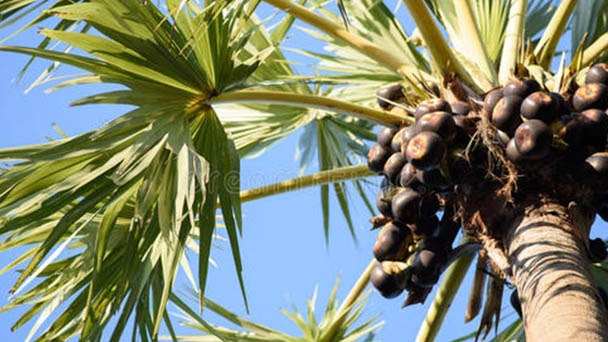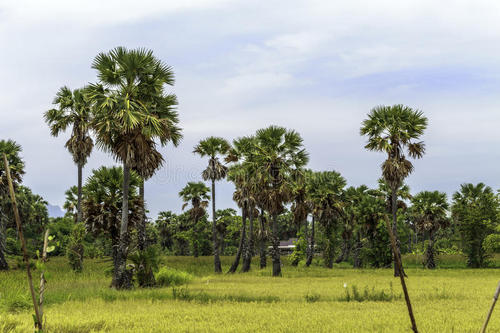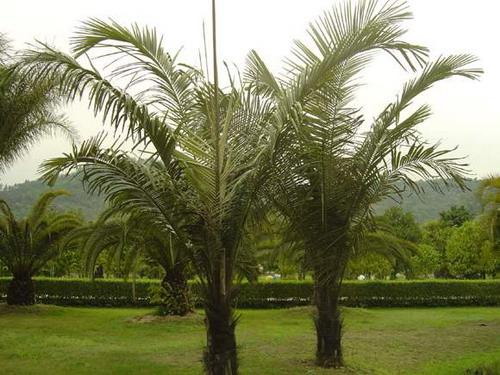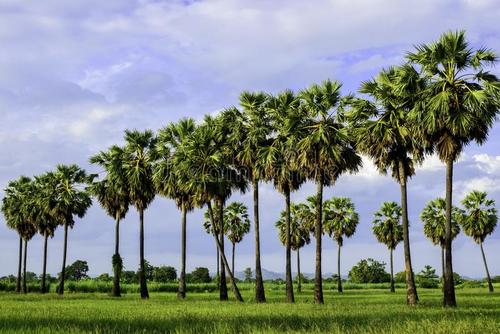Sugar palm (Arenga pinnata) profile
Written by Maggie
Mar 04 2021

Sugar palm, scientific name Arenga pinnata, also called reng palm, black sugar palm, and kaong palm, is a plant of the genus Sugar palm in the palm family. Sugar palm is arboreal, mostly born in dense forests, and has high economic value. It is also a good plant for shape, leaf and fruit observation in gardens.
Sugar palm picture

Sugar palm info
| Botanical Name | Arenga engleri |
| Common Names | reng palm, black sugar palm, and kaong palm |
| Plant Type | Needled evergreen |
| Mature Size | up to 20ft high |
| Water Req | moderate |
|
Cold Tolerance |
down to 25F |
| Sun | full sun to partial shade |
Morphological characteristics of sugar palm
The arbor shape, the stem is more stout, 5 meters to 10 meters high, 15 to 30 centimeters in diameter, has the distantly annular leaf mark. Leaves of Sugar palm are clustered at the apex of the stem, 5 -- 6 m or more long, pinnately lobed, pinnacles arranged in 2 rows, linear or linear-lanceolate, 80 -- 150 cm long, 2.5 -- 6.5 cm wide or wider, often uneven earlobes on both sides of the base, irregular roasting teeth or 2 lobes at the top, green above, pale on the back; Leaf sheaths with black strong reticulate fibers and needle-like fibers.
Inflorescences of Sugar palm are axillary, from the top to the bottom of a few inflorescences, when the fruit of the lowest inflorescences mature, the plant is dead; Inflorescences are 90 -- 150 cm long, peduncles stout, recurved, branched, 1.5 m long, multiple spathe, spirally arranged on the peduncles; Male flowers of Sugar palm are large, 1.5 ~ 2 cm long, calyx, petals 3, stamens up to 100 or more; Female flowers: calyx and petals 3 each, dilated after anthesis.
Fruit of Sugar palm is subglobose, 4 -- 5 cm in diameter, trigonal, tip concave, grayish brown (immature fruit is black when dried). Sugar palm has 3 seeds, black, ovate triangulate, hanging endosperm uniform, embryo dorsal health.
Ecological habits of sugar palm
Sugar palm likes a high temperature and humidity, cold resistance is very low, avoid frost, in the long-term 5~6℃ low temperature or light frost, leaf dead. In Guangzhou, Nanning and other places, normal years can be overwintered in open fields, and in extremely cold years, the leaves have cold damage, so a small environment should be strictly selected for planting. Sugar palm is a forest plant with strong wildness, avoiding the scorching sun and tolerating shade. When young, it needs to cover winter and summer, and mature trees can withstand direct sunlight.
Sugar palm likes fertile moist forest soil, sticky heavy land can also grow, more durable water wet, drought tolerance, the most suitable for planting in the forest park under the shade, the ground needs to dig a big Canton for soil, application of decroping human and animal manure or cake fertilizer as a base fertilizer, after survival, generally can let its natural growth.
The sugar palm distribution area
Sugar palm is produced in Hainan, Guangxi and western to southeastern Yunnan. The Indochina Peninsula and Southeast Asia area also produced; India, Sri Lanka, Malaysia and Australia also have it. Sugar palm is more in the dense forest, but also cultivated.
Growing sugar palm
Sugar Palm likes moist soil and is not very good at tolerating drought. It prefers partial shade to full sun. Sugar Palm is hardy and can tolerate cold up to 25F for a short period of time after establishing.

Sugar palm propagation
Sugar palm is propagated by seeds.
If you enjoy reading my articles, please help me to promote the Florida Palm Trees site by social bookmarking it.
The purpose of the sugar palm
Sugar palm inflorescence juice can make sugar, wine; The sheath fibers are strong and resistant to moisture and decay and can be used to make cables.
The heart of the pith contains starch and can be eaten. Sugar palm powder is a traditional specialty of Guangxi, which is made from the unique Sugar palm tree in the deep mountains in the southwest of Guangxi, and is a treasure in the forest nutrition food.
The tender endosperm of the seeds can be preserved by boiling in sugar (note: the juice of the pulp is highly irritating and corrosive, and the seeds must be carefully removed); The young stem tips can be eaten as vegetables.
Landscape use of sugar palm
Beautiful tree shape, suitable for garden landscape trees, or as an independent tree, or with stone planting.
The toxicity of sugar palm
The fruit of Sugar palm is poisonous. But the pulp and seeds after boiling, soaking and other processing can be edible, if not enough to poison, can cause poisoning, the main symptoms have dizziness, vomiting, like drunk feeling. Mice were intraperitoneally injected with 10.3g/kg fruit water extract, respiratory depression was observed, the turning reflex disappeared, and finally died.

Latest Updated
- Benefits of Bugleweed - 7 Science-backed Health Benefits
- Bugleweed Dangers & Side Effects - Is It Poisonous?
- How to Plant Evergreen Trees - What You Should Know
- When to Plant Evergreens - Grow Guide for Evergreen Trees
- 12 Wonderful Evergreen Shrubs for Your Garden
- 12 Popular Evergreen Plants with Pictures for Beginners
- When And How To Prune A Lilac Bush Like a Pro
- How to Grow & Care for Lilac Vine (Hardenbergia Violacea)
- Japanese Lilac Tree (Syringa Reticulata) Care & Propagation Guide
- Shumard Oak Pros and Cons - What to Know
Popular Articles
- Winter maintenance of Antirrhinum Majus
- How to Grow Terminalia Mantaly Tree
- How to Grow and Care for Crossostephium Chinense
- How to grow Antirrhinum Majus in spring
- Peristeria Elata (Dove Orchid) Profile: Info & Care Guide
- Underwatered Snake Plant (Sansevieria Trifasciata) - Signs And How To Fix
- How to Care for Brazilian Jasmine Plant (Mandevilla Sanderi)
- How to Grow & Care for Graptopetalum Purple Delight in Summer
- Rosa Chinensis (China Rose): Plant Growing & Care Tips
- How to Care for Baby Sun Rose (Aptenia Cordifolia)